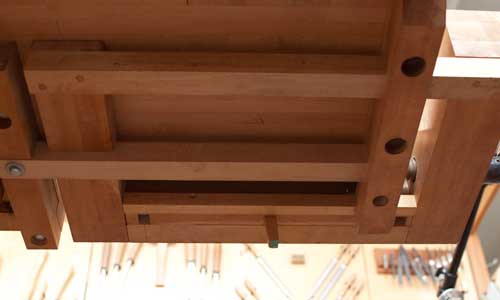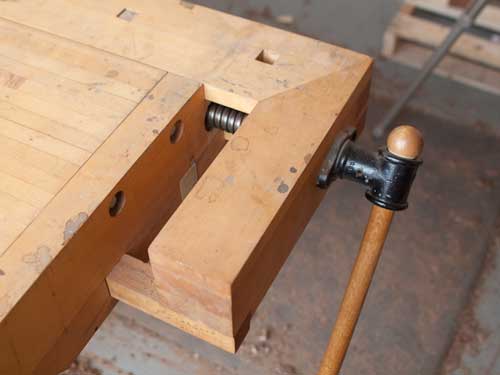|
|
|
 Joel's Blog Joel's Blog |
 Built-It Blog Built-It Blog |
 Video Roundup Video Roundup |
 Classes & Events Classes & Events |
 Work Magazine Work Magazine |
| Newer Entries... | |
 | Ron Hock Is Laughing At Me Right Now - 02/08/2011 |
 | A Desk I Would Like To Make - 02/03/2011 |
 | How To Camber A Plane Iron (And Why It Works) - 01/26/2011 |
 | Cheater Pastrami and Getting Stuff Done - 01/20/2011 |
 | Winding Sticks - 01/18/2011 |
 | Dye Young - Stain Pretty - 01/13/2011 |
 | Where the Factory Was - 01/11/2011 |
 | New for 2011 - 12/30/2010 |
 | Truer Grit - 12/25/2010 |
 | The Traditional Tail Vise - Followup - 12/21/2010 |
 | The Argument for a Traditional Tail Vise - 12/16/2010 |
 | Some Tips on Using Our Gramercy Holdfasts - 12/14/2010 |
 | New Book: The Boy Joiner and Model Maker - 12/09/2010 |
 | Coursework - Books that You Can Learn From - 12/07/2010 |
 | Introducing The Gramercy Tools Veneer Saw - 12/02/2010 |
 | Wood - In the Rough or What? - 11/30/2010 |
 | Tool Test - Norris A5 - How Well Do They Work? - 11/24/2010 |
 | Ray Iles Adds A 1/8 Inch Mortise Chisel To The Line - 11/22/2010 |
 | Resources - Information is Power - EEBO! - 11/18/2010 |
 | Native South American Shovels, Axes, and Machetes - Made In England - 11/16/2010 |
| Older Entries... | |
|
Hours: M-F 9:00-5:00, closed Sat,Sun Our Guarantee & Return Policy Shipping and Sales Tax Info Privacy Policy Holiday Calendar |
|
Contact Us:
Email: support@toolsforworkingwood.com Phone: 800-426-4613 or 718-499-5877 Visit Us in Brooklyn: Directions to Our Showroom © 1999-2019 toolsforworkingwood.com Powered by 01 Inc. Coded entirely in NYC |




 My vise does sag a little. It's not wear - it's imprecise construction. I figured this out about a day after I finished the vise and I promised myself I would fix it right away. But the vise works great, sag hasn't been an issue, so don't hold your breath for a fix.
My vise does sag a little. It's not wear - it's imprecise construction. I figured this out about a day after I finished the vise and I promised myself I would fix it right away. But the vise works great, sag hasn't been an issue, so don't hold your breath for a fix. 
A couple of things have improved its usefulness. I lined the jaw meeting faces with masonite, rough side out. Workpieces are held in a much better grip than before (thanks, Ron Brese, for the tip).
I made wooden bench dogs for each dog hole. This is really living, now!
Finally, I personally love the bench looking clean and free of spots. Another workbench handles rough objects, stains, and glue, but my primary hand tool bench looks so great and inspires me when I craft objects on it.
You do a great work and it is awssome to have you around(even if I'm more than 7000Km away!!)
Cheers
I wonder what Frank Klausz would have to say about it. This classic bench has so many well thought-out features based on the hand tool working experiences of generations of craftsman, that there would probably be an important reason for it being the way it is. You want to use the bench above where it is supported by the leg for heavy chopping, so perhaps that's the reason, giving some distance away from the leg vice opening for boards to lie on and be clamped.
http://www.planemaker.com/photos/old-bench.jpg
How about chopping and heavy pounding? Do you find that it's not an issue with the unsupported top over the longer span?
I doubt many people pound on their bench as much as my former partner did when he completely chopped bench plane escapements by hand. The benches did just fine under that punishment.
Would you happen to have a shot of the tail vise from the other side of the bench so that I can better understand what you are describing? Thanks.
premodern@gmail.com
To the best of my ability to check, the top has remained as flat as when I made it. I love it, and both vises do exactly what is needed and have required no tuning, although I periodically check them. I would be happy to dialog with Steve if he has a mind to do so...
Larry